Akt contributes to neuroprotection by hypothermia against cerebral ischemia in rats
- PMID: 16237183
- PMCID: PMC6725740
- DOI: 10.1523/JNEUROSCI.3163-05.2005
Akt contributes to neuroprotection by hypothermia against cerebral ischemia in rats
Abstract
Activation of the Akt/protein kinase B (PKB) kinase pathway can be neuroprotective after stroke. Akt is activated by growth factors via a phosphorylation-dependent pathway involving the kinases phosphoinositide 3 (PI3) kinase and phosphoinositide-dependent protein kinase-1 (PDK1) and is negatively regulated by phosphatase and tensin homolog deleted on chromosome 10 (PTEN). Akt kinase blocks apoptosis by phosphorylating the substrates forkhead transcription factor (FKHR) and glycogen synthase kinase 3beta (GSK3beta). We found that intra-ischemic hypothermia (30 degrees C) reduced infarct size and improved functional outcomes up to 2 months. Changes in phosphorylation levels of Akt, as measured by Western blots and immunostaining, differed from levels of Akt activity measured in an in vitro assay in normothermic animals. Hypothermia blocked most of these changes and maintained Akt activity. Inhibition of PI3/Akt enlarged infarct size in hypothermic animals. Hypothermia improved phosphorylation of PDK1, PTEN, and FKHR. Hypothermia did not improve GSK3beta (Ser9) phosphorylation but blocked the nuclear translocation of phosphorylated beta-catenin (Ser33/37/Thr41) downstream of GSK3beta. Phosphorylation levels of PTEN, Akt, and Akt substrate decreased before apoptotic cytochrome c release and degradation of microtubule-associated protein-2, a marker of neuronal survival. Hypothermia may protect from ischemic damage in part by preserving Akt activity and attenuating the apoptotic effects of PTEN, PDK1, and FKHR.
Figures
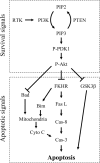



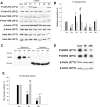
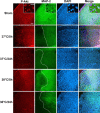

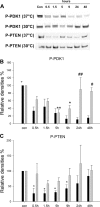
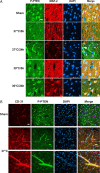
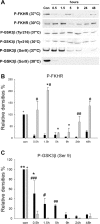
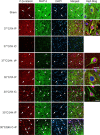
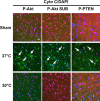
Similar articles
-
Phosphoinositide-3-kinase/akt survival signal pathways are implicated in neuronal survival after stroke.Mol Neurobiol. 2006 Dec;34(3):249-70. doi: 10.1385/MN:34:3:249. Mol Neurobiol. 2006. PMID: 17308356 Review.
-
The Akt signaling pathway contributes to postconditioning's protection against stroke; the protection is associated with the MAPK and PKC pathways.J Neurochem. 2008 May;105(3):943-55. doi: 10.1111/j.1471-4159.2008.05218.x. Epub 2008 Jan 7. J Neurochem. 2008. PMID: 18182053 Free PMC article.
-
Activation of the Akt/GSK3beta signaling pathway mediates survival of vulnerable hippocampal neurons after transient global cerebral ischemia in rats.J Cereb Blood Flow Metab. 2006 Dec;26(12):1479-89. doi: 10.1038/sj.jcbfm.9600303. Epub 2006 Mar 15. J Cereb Blood Flow Metab. 2006. PMID: 16538228
-
Dihydrocapsaicin (DHC) enhances the hypothermia-induced neuroprotection following ischemic stroke via PI3K/Akt regulation in rat.Brain Res. 2017 Sep 15;1671:18-25. doi: 10.1016/j.brainres.2017.06.029. Epub 2017 Jul 3. Brain Res. 2017. PMID: 28684048
-
Cerebral metabolic rate and hypothermia: their relationship with ischemic neurologic injury.J Neurosurg Anesthesiol. 1995 Jul;7(3):216-21. doi: 10.1097/00008506-199507000-00021. J Neurosurg Anesthesiol. 1995. PMID: 7549375 Review.
Cited by
-
PI3K/Akt Pathway Contributes to Neurovascular Unit Protection of Xiao-Xu-Ming Decoction against Focal Cerebral Ischemia and Reperfusion Injury in Rats.Evid Based Complement Alternat Med. 2013;2013:459467. doi: 10.1155/2013/459467. Epub 2013 May 28. Evid Based Complement Alternat Med. 2013. PMID: 23781261 Free PMC article.
-
A novel pharmacological strategy by PTEN inhibition for improving metabolic resuscitation and survival after mouse cardiac arrest.Am J Physiol Heart Circ Physiol. 2015 Jun 1;308(11):H1414-22. doi: 10.1152/ajpheart.00748.2014. Epub 2015 Mar 20. Am J Physiol Heart Circ Physiol. 2015. PMID: 25795713 Free PMC article.
-
Hypothermia and brain inflammation after cardiac arrest.Brain Circ. 2018 Jan-Mar;4(1):1-13. doi: 10.4103/bc.bc_4_18. Epub 2018 Apr 18. Brain Circ. 2018. PMID: 30276330 Free PMC article. Review.
-
Akt isoforms differentially protect against stroke-induced neuronal injury by regulating mTOR activities.J Cereb Blood Flow Metab. 2013 Dec;33(12):1875-85. doi: 10.1038/jcbfm.2013.132. Epub 2013 Aug 14. J Cereb Blood Flow Metab. 2013. PMID: 23942361 Free PMC article.
-
Neuroprotection by PGE2 receptor EP1 inhibition involves the PTEN/AKT pathway.Neurobiol Dis. 2008 Mar;29(3):543-51. doi: 10.1016/j.nbd.2007.11.010. Epub 2007 Dec 4. Neurobiol Dis. 2008. PMID: 18178094 Free PMC article.
References
-
- Abe T, Takagi N, Nakano M, Furuya M, Takeo S (2004) Altered Bad localization and interaction between Bad and Bcl-xL in the hippocampus after transient global ischemia. Brain Res 1009: 159-168. - PubMed
-
- Bederson JB, Pitts LH, Tsuji M, Nishimura MC, Davis RL, Bartkowski H (1986) Rat middle cerebral artery occlusion: evaluation of the model and development of a neurologic examination. Stroke 17: 472-476. - PubMed
-
- Bellacosa A, Chan TO, Ahmed NN, Datta K, Malstrom S, Stokoe D, Mc-Cormick F, Feng J, Tsichlis P (1998) Akt activation by growth factors is a multiple-step process: the role of the PH domain. Oncogene 17: 313-325. - PubMed
Publication types
MeSH terms
Substances
Grants and funding
LinkOut - more resources
Full Text Sources
Other Literature Sources
Medical
Molecular Biology Databases
Research Materials
Miscellaneous
